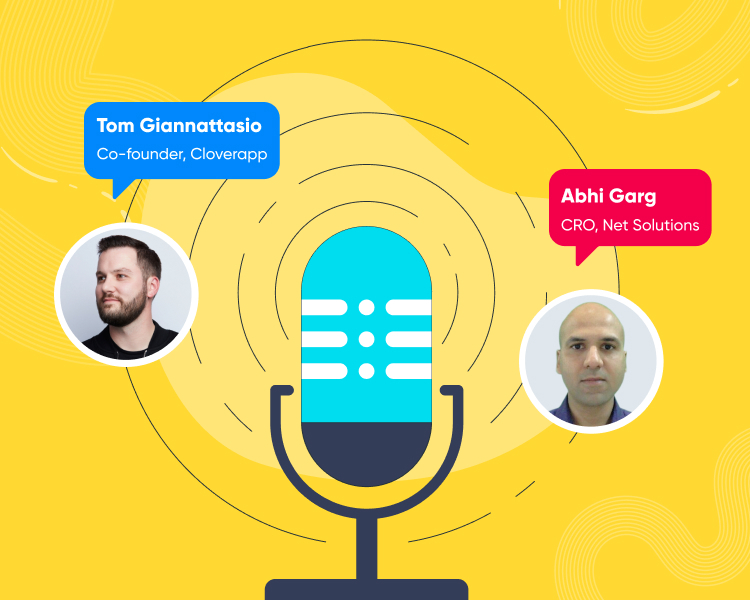The expansion and accelerated adoption of digital products has led to a meteoric rise of app-based products & services. But a trend is not enough to successfully build and scale a startup.
What considerations apply to Enterprise product development?
Our conversation with Tom Giannattasio, co-founder of Clover app answers some of these questions and digs into what matters, from a UX perspective, when starting out or working on a successful product.
1. Focus on Research
A lot of startups make the mistake of going all in on the basis of imaginative needs of users and unvalidated conviction. They try to figure out the market-fit later on.
A common excuse that comes up is that as a startup, they do not have the budget and resources that the established players have. Tom mentions that even as a startup, research is important to see the returns on your investment in time and money. For a startup the research should not focus on whether this design would look best or not but rather on trying to solve a ‘real’ customer problem unless you’re Apple, of course, where you tell the customers about a problem they don’t know exists 🙂
6-9 months of slog later, if you manage to build a beautiful product that no one wants, then it’s a wasted spin of wheels.
Understanding the end-user is the key but a broken, inconsistent user experience built on vague user feedback is not the way to go.
A better way that helps you gain invaluable insight in a timely fashion is ethnographic research requirements analysis method.
It is a qualitative research method that allows for observing users in their real-life and capture first-hand experiences and not hearsays. This helps you with validated insights that prove or disprove your hypothesis.
The best part is that it costs you nothing to go talk to your potential customers.
2. Build the Right Team
Having the right UX team to work on your startup is indispensable. When building a team, a very important trait to look for is humility.
A question Tom never fails to ask when bringing someone on board is: “What do you feel you will have trouble with in this new role?”
The second trait to pay attention to, is curiosity: As work from home becomes the norm and teams are distributed, having a motivated team is important. More important, however, is having teammates that have an inquisitive and curious mind. Tom suggests that when hiring, businesses should ask the question: What do you do outside of your work?
A person who is curious about the world will dip their fingers in multiple pies and learn and broaden their horizons. If the person has that drive, that approach to life, they will bring the same zeal and energy to their work.
When hiring is a bottleneck, startups & businesses can bring outside help in the form of Staff Augmentation.
3. Bring in the User Experience
While UX was a nice to have in previous decades, businesses are now realizing that designing products for the end-user takes precedence over pushing out products developed with business-centric elements.
Simply put, design that ignores people gets pushed aside.
The rise of Netflix over Blockbuster gives us some of the earliest insight into that matter.
The core essence of Netflix sticks to what Blockbuster offered. But ridiculous late fees, driving back and forth for products and rewinding the tapes were hassles that Netflix addressed and offered a superior user experience for ‘watch-at-home’ customers. Netflix solved all the customer experience issues.
A more modern and time-relevant example is Amazon. Amazon revolutionized the digital shopping experience, firstly by having a robust recommendation mechanism and later integrating it with 1-tap frictionless checkout process. Amazon took it a step further with cashier-less stores.
Investing in end-user experience has thus become non-negotiable.
4. Integrate Design System and Language
As UX and design has shifted from nice to have add-ons to being an integral part of product development, a consistent design system and a design language is a must for enterprises looking to offer cutting-edge user experience.
A scrappy approach to design, with haphazard color schemes and inconsistent design elements will leave the business chasing tails of competitors that have a designated design system. As the design language world matures, it is easier to visualize and think about the design process and what is the aim of the design.
It is not a boulevard of touchpoints and feedback points lined up one after the other but a nexus of collaborative touchpoints that help the design mature and breathe. Small atomic pieces that can be used to compose solutions is a much better and scalable approach that shows consistency and also makes designing faster, and eliminates the need to resolve problems again and again.
5. Be the User
Great products can be born when you have been the user yourself and then take the show on the road.
Tom shares how he was scratching an itch and experimenting with tools which led him to Macaw and Clover. He built 10-11 iterations of a text editor and believes the evolution of text editor was responsible for advancement of software development.
Being knowledgeable about the ins and outs of a product you have used previously, knowing its limitations, and a general curiosity to make it better are the seeds to build a product that is user-centric.
The Takeaway
As digitalization gets embedded further in day to day tasks and routines, delivering a stellar user experience is not a matter of brownie points. Good UX leads to higher customer retention and business growth. Talking to the end-users will help startups put themselves in their users’ shoes and understand how they interact with the product across multiple touch-points.
You can listen to the complete conversation between Abhi Garg and Tom Giannattasio here:
A bit about Tom: Tom is a design artist turned developer turned founder. He has previously worked on design projects for Apple, LinkedIn, Twitter and bootstrapped Macaw to a successful acquisition. He was also an author and editor at Smashing Magazine.
You can get in touch with Tom at his twitter handle.


 Updated: September 6, 2021
Updated: September 6, 2021





